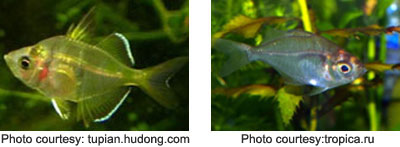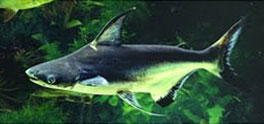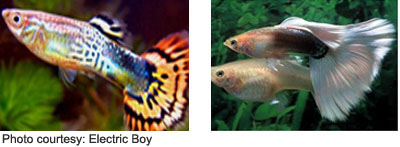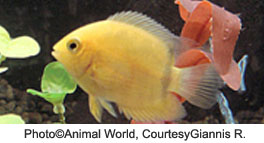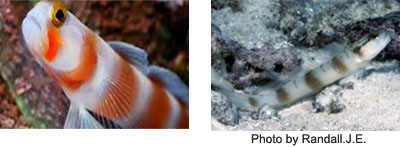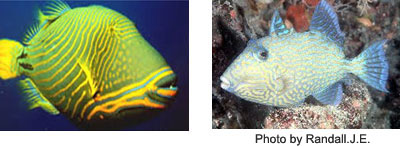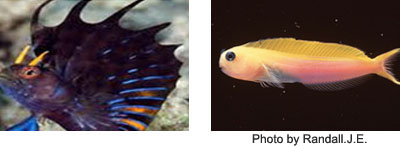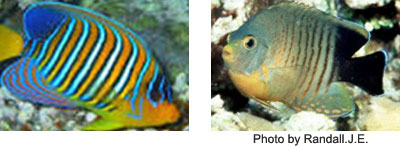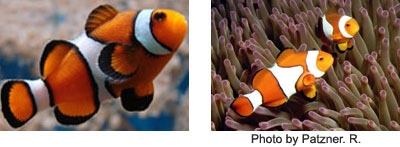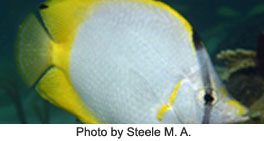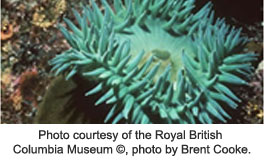ORNAMENTAL FISHES IMPORTANT SPECIES

COMMERCIALLY IMPORTANT FRESHWATER ORNAMENTAL FISHES
COMMERCIALLY IMPORTANT MARINE ORNAMENTAL FISHES
 Barbs, members of the Cyprinidae family, comprise more than 400 species in their entire range, which extends from Africa, Asia and Europe to Central China, the Philippines and the East Indies. About 150 species of barbs are of ornamental value, comprising mostly of wild caught varieties. Barbus tetrazona (Tiger barb), B conchonius (Rosy barb) and Puntius titteye (cherry barb) are the most common barbs in the aquarium industry. P. denisonii, a wild caught variety of barb is mainly found in Kerala and Karnataka
Barbs, members of the Cyprinidae family, comprise more than 400 species in their entire range, which extends from Africa, Asia and Europe to Central China, the Philippines and the East Indies. About 150 species of barbs are of ornamental value, comprising mostly of wild caught varieties. Barbus tetrazona (Tiger barb), B conchonius (Rosy barb) and Puntius titteye (cherry barb) are the most common barbs in the aquarium industry. P. denisonii, a wild caught variety of barb is mainly found in Kerala and Karnataka
Loaches, commonly known as Botia, are belonging to the family Cyprinidae. There are around 40 species of loaches known today, belonging to the genus Botia. They are natives of Thailand, India, Pakistan, China, Bangladesh and some Indonesian Islands. They are probably the most diverse group of fish in the hobby, both in pattern and behaviour.
Danios, another member of the Cyprinidae family, are small and lively fish which are native to the Indian peninsula, Sri Lanka, Pakistan, Thailand, Myanmar, Malaysia and Indonesia. They are found in a variety of habitats from boulder-strewn mountain torrents to small pools in dry zone streams. There are more than 12 species reported today of which Danio malabaricus (Pearl Danio), D. albolineata and Brachydanio rerio (zebra fish) are common in the hobbyist market. Brachydanio rerio is mainly found in Kerala and Karnataka
Freshwater sharks are different types of minnows, belonging to four genera, Balantiocheilos, Epalzeorhynchos, Labeo and Luciosoma, under the Cyprinidae family. They are commonly referred to as freshwater sharks in the hobby market. These minnows are widely distributed over Southeast Asia, the Malay Archipelago, Indonesia, and parts of the Middle East and Africa. Genus Epalzeorhyncho have four types of fresh water sharks, E. bicolor, E. frenatus, E. kalopterus, and E. munense. The genus, Labeo has over a hundred species, of which two species, Labeo chrysophekadion and L. cyclorhynchus are popular in the aquarium trade. The genus, Luciosoma has five species, of which one, L. siplopleura, is popular in the hobby. Bala shark, as popularly known, is a short form of its Latin name, Balantiocheilus melanopterus, are native of Malaysia, Thailand, Cambodia and Indonesia (Sumatra and Borneo)
Gourami, the labyrinth fish, is a native of western and southern Africa, northeastern, southeastern, south and Southeast Asia. Colisa lalia, the Dwarf Gourami, occurs naturally in freshwater ponds, streams and paddy fields of northeastern India and Bangladesh, and is most popular among the Gouramis. Important varieties include The Honey Gourami (C. chuna), Indian Gourami (C. fasciata), Thick-lipped Gourami (C. labiosa), three spot gourami (Trichopodus trichopterus), Pearl Gourami (T. leeri), Snakeskin (T. pectoralis), Moonlight Gourami (T. microlepis) and the Kissing Gourami (Helostoma temmincki).
Corydoras, commonly known as catfish, is belonging to the family Callichthydae. They are natives of South America particularly Brazil, Uruguay, northern Argentina, Venezuela, Peru and Colombia. The common species found in the hobby market are Corydoras ambiacus, C. agaassizii, C. leucomelas, C. schwa rtzi, C. punctatus, C. parallelus, C. pulcher and C. ornatus.
Spiny eels or swamp eels are members of the family Mastacembelidae. They are distributed in India, Pakistan, Sri Lanka, Bangladesh, Nepal, Myanmar, Thailand, Malaysia, Vietnam and Indonesia. Macrognathus aculeatus (spotted spiny eel) and Mastacembalus armatus, (zigzag eel) are of much importance as far as the ornamental fish market is concerned. Macrognathus aculeatus is commonly referred to as the peacock eel or spotted spiny eel. These are mainly found in West Bengal, Tamil Nadu, Kerala and Maharashtra.
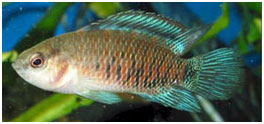 Badis badis, a native of India, Thailand and Myanmar, belongs to the Nandidae family. It is better known as the dwarf chameleon fish as it changes its colour quite often depending on mood and environment, especially during courtship and breeding. Badis has three sub species, Badis badis badis found in India, B. badis siamensis of Thailand and B. badis burmanicus from Myanmar. Badis badis badis, is native of Indian sub continent is from the northeastern side.
Badis badis, a native of India, Thailand and Myanmar, belongs to the Nandidae family. It is better known as the dwarf chameleon fish as it changes its colour quite often depending on mood and environment, especially during courtship and breeding. Badis has three sub species, Badis badis badis found in India, B. badis siamensis of Thailand and B. badis burmanicus from Myanmar. Badis badis badis, is native of Indian sub continent is from the northeastern side.Puffer fish are members of the family, Tetraodontidae, having a worldwide distribution and found in almost every water condition. They are quite different from other ornamental fishes in appearance. The fresh water puffers include Carinotetraodon lorteti, C. salivator, Monotetrus travancoricus, Chonerhinos amabilis, C. nefastus, C. modestus, C. remotus, C. asellus, Colomesus asellus, and C. psittacus. Monotetrus travancoricus, popularly known as Malabar or dwarf pufferfish, is a native of India and is considered as the smallest puffer in the trade. T. fluviatilus, known as the Ceylon puffer, is a native of Sri Lanka, India, Bangladesh, Myanmar and Borneo.
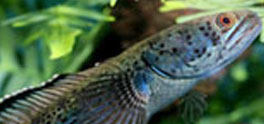 The snakeheads are characterized by their torpedo shaped body, large scale plated head and log dorsal and anal fins. 28 species of Channa are known today, C. bleheri, C. burmanica, C. gachua, C. micropeltes, C. lucius, and C. orientalis, are well known in the aquarium trade. C .bleheri is widely known as the rainbow snakehead because of its body colouration. It originates from the upper region of north eastern India, particularly in the Brahmaputra river basins of Assam.
The snakeheads are characterized by their torpedo shaped body, large scale plated head and log dorsal and anal fins. 28 species of Channa are known today, C. bleheri, C. burmanica, C. gachua, C. micropeltes, C. lucius, and C. orientalis, are well known in the aquarium trade. C .bleheri is widely known as the rainbow snakehead because of its body colouration. It originates from the upper region of north eastern India, particularly in the Brahmaputra river basins of Assam.
C. gachua or dwarf snakehead found in rainforest streams of Sri Lanka. They are also found in Southeastern Iran, Eastern and Western Pakistan and Southern China.
Glassfish, belonging to the family Chandidae or Ambassidae, comprise mostly of fish with transparent bodies. They originate from Asia, especially Pakistan, India, Nepal, Bangladesh, Myanmar and Thailand. There are four species commonly referred to as glassfish in the trade: Chanda ranga, C. lala, C. nama and C. baculis.
t
The guppy (Poecilia reticulata), also known as ‘rainbow fish’ is one of the world’s most widely distributed tropical fish, and one of the most popular freshwater aquarium fish species. It is a member of the Poecillidae family and is live bearing. The origin is from Central America to Brazil and West Indies. They are also known as “millions fish” as they are prolific breeders. Depending on the variations in the tail fins, they are also known as round tail, spear tail, fan tail, veil tail, pin tail etc.
Black molly, Poecilia sphenops, is a native of Central America, from Mexico to Columbia; sail fin molly (P. latipinna) is from Southeastern North America, from the Carolinas through the Gulf coast of Southern Mexico while Lyre tail molly (P. velifera) is found in the streams of Southern Mexico. Molly is very familiar fish in the aquarium. About 25 strains of molly are being cultured and traded in the market, black molly being well-known.
The gold fish (Carassius auratus) is considered to be the most popular and attractive pet fish among all ornamental fishes, due to its many variations such as colour, fin shape, size and body structure. Though similar in appearance to carp (Cyprinus carpio), gold fish lack barbels and a dark spot at the base of each scale. The goldfish is the most common aquarium fish and one of the oldest and best-known fish in the industry.
The Platy (Xiphophorus maculatus) belonging to the family Poeciliidae is native to the east coast of Central America and Southern Mexico. It is a live bearer and most popular among aquarium fishes. Several different colour variations have been developed so far such as red, yellow, orange, blue and white. Three species are commonly available; they are Southern Platy (Xiphophorus maculatus), Variatus Platy (X. variatus) and Swordtail Platy (X. xiphidium).
Sword tail is a native of North and Central America stretching from Veracruz, Mexico, to northwestern Honduras belonging to the family Poeciliidae. Swordtails (Xiphophorus hellerii) have been interbred to produce all kinds of interesting colors and different types of finnage. Some of the more common varieties of the Swordtail are Red, Red Wag, Red Tux, Painted, Neon Green, Marigold (and wag), Pineapple, Black, Red Twin bar, Sunset, and Gold Tuxedo.
Siamese fighting fish (Betta splendens) is a popular aquarium fish coming under the family Osphronemidae. They are native of Mekong basin of Laos, Cambodia, Vietnam and Thailand. The colour patterns of this species ranges from vivid red, blue, bright green, purple, white, black to cream with red fins. Apart from coloration, the finnage also have varieties like veil tail, crown tail, half moon, butterfly, double tail etc. The males are very aggressive towards other males of their own kind and fight ferociously until death, hence the name of the fish.
Angel fish (Pterophyllum scalare) are very popular and a favorite among hobbyist as they are beautiful and look graceful in the aquarium. In Asia, there are about 25 varieties now with unique colour patterns. They are single coloured ones like black, silver and gold and multi coloured pattern ones such as leopard, striped or zebra and lace-like, mottled or marble, half black etc. Black veil tail, diamond, ghost, blushing, golden marble, pearl scale and koi are the other popular varieties in Asia. They originate from South American rivers and tributaries such as the Amazon basin and Guyana River where the water bodies have densely over grown by aquatic plants. Angel fish prefer an environment with thick aquatic vegetation.
Discus (Symphysodon sp), members of cichlid group, is said to be the queen of the aquarium, native to South America, found in slow-flowing streams with alkaline water.The wild forms are blue discus (S. aequifa sciatus haraldi) the green discus (S. aequifasciata), Heckel discus (S. discus) and brown discus (S. aequifasciatus axelrodi). The wild blue discus is distributed in the rivers of Peru and Brazil while green discus is found mainly in the Peruvian Amazon. The blue discus has a wide variety of blue colouration with some being more bluish while others have blue stripes on the body, head and fins. The green discus has also varying degree of colours ranging from yellowish green to olive green and solid green to light brown and have green stripes and red spots on the sides of the body.
Tetra is one of the several small species of freshwater fishes from Africa, Central America and South America belonging to the biological family Characidae. There are ten varieties of tetras known, which are Neon tetras (Paracheirodon innesi), Cardinal tetra (Paracheirodon axelrodi), Black neon (Hyphessobrycon herbertaxelrodi), Black tetra (Gymnocorymbus ternetzi), Bleeding heart tetra (Hypessobrycon erythrostigma), Blood fin (Aphyocharax anisitsi), glow light tetra (Cheirodon erythrozonus), Head and tail light tetra (Hemigrammus ocellifer), Lemon tetra (Hyphessobrycon pulchripinnis), Serpae tetra (Hyphessobrycon callistus). They are peaceful and pose no threat to any other fish in the aquarium and are ideal for a community aquarium with other fish of similar disposition.
The gobies are small colourful species, usually solitary, sedentary, bottom dwelling fishes. The species include Amblyeleotris gymnocephala (masked shrimp goby), Mahidolia mystacina (Flagfin prawn goby), Paragobiodon echinocephalus,(Redhead goby), Periophthalmus argentilineatus (Barred mud skipper), P.barbarus (Atlantic mud skipper), Priolepis eugenius (Noble goby), P. inhaca (Brick goby), Trimma annosum (Grey beared pygmy goby), T. winterbottomi (Winterbottom’s goby), Valenciennea muralis (Mural goby), V. sexguttata (Sixspot goby), V. strigata (Blueband goby) . It can be found in mangrove ecosystems and mudflats of East Africa and Madagascar east through the Sundarbans of Bengal, Southeast Asia to Northern Australia, southeast China, and southern Japan, to Samoa and Tonga Islands.
These are often brightly colored fishes of the family Balistidae. Often marked by lines and spots, they inhabit tropical and subtropical oceans throughout the world, with the greatest species richness in the Indo-Pacific. The species recorded are Balistapus undulatus ( Orange – lined triggerfish), Balistes vetula (Queen triggerfish), Balistoides conspicillum (Clown triggerfish), B. viridescens (Titan triggerfish), Melichthys niger ( Black triggerfish), Odonus niger ( Redtoothed triggerfish), Psuedobalistes flavimarginatus (Yellow margin triggerfish), P. fuscus (Yellow spotted triggerfish), Rhinecanthus aculeatus (Black bar triggerfish), R. rentangulus (Wedge – tail triggerfish), (Sufflamen chrysopterum (Halfmoon triggerfish) and S. fraenatum ( Masked triggerfish).
The blennies are small carnivorous fishes. Most species have drab colours which harmonise with their environment, but some are brilliantly coloured. The species recorded are Andamia reyi (Suckerlip blenny), Blenniellia periophthalmus (Bluedashed rock skipper), Cirripectes castaneus (Chest nut eyelash blenny), C. filamentosus (Filamentous blenny), C. perustus (Flaming blenny), C. polyzona, C. quagga (Squiggly blenny), C.stigmaticus (Red streaked blenny) C. variolosus (Red speckled blenny), Ecsenius midas ( Persian blenny), Enchelyurus kraussii (Krauss’ blenny), Exallias brevis (Leopard blenny), Salarias fasciatus (Jewelled blenny). Blennies are found in tropical and subtropical waters in the Atlantic, Pacific and Indian Oceans; some species are also found in brackish and even freshwater environments.
Angelfishes are small to moderate brilliantly coloured fishes. They are subject to startling changes of colour and pattern as they grow. Favourite aquarium fishes, especially when small. The species recorded are Centropyge bicolor (Bicolor angelfish), C. eibli (Blacktain angelfish), C. multispinis (Dusky angelfish), Chaetodontoplus melanosoma (Black- velvet angelfish), Pomacanthus annularis (Blue ring angelfish), P. imperator (Emperor angelfish) and P. semicirculatus (Semicircle angelfish).
Clown fishes are hardy, typically highly coloured and are in good demand in the marine aquarium trade. Clown fishes usually live in association with the sea anemones and also called anemone fish. Clown fishes exude a mucous substance which protects them from the stings of the anemone; when alarmed they immediately take shelter among the tentacles of the anemone, but never straying far. Clown fishes swim with an odd rising and falling waddling, wriggling motion which has earned them the name of clown fishes. Major clown fish species are Amphiprion ocellaris (Clown anemone fish), A. percula (Orange clown fish), A. bicinctus (Two band anemone fish), A. chrysogaster (Mauritian anemone fish), A. ephippium (Saddle anemone fish), A. frenatus ( Tomato clownfish), A. nigripes (Maldive anemone fish), A. polymnus (saddleback clownfish ), A. sebae (Sebae anemone fish).








